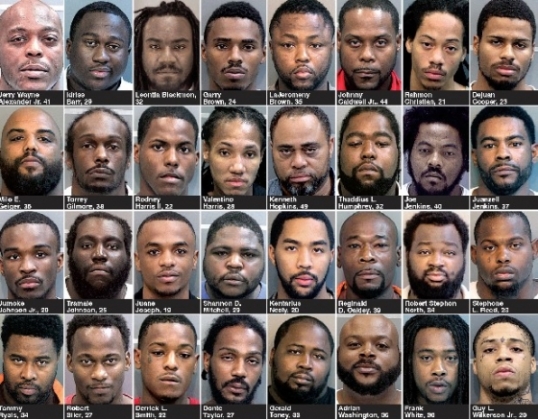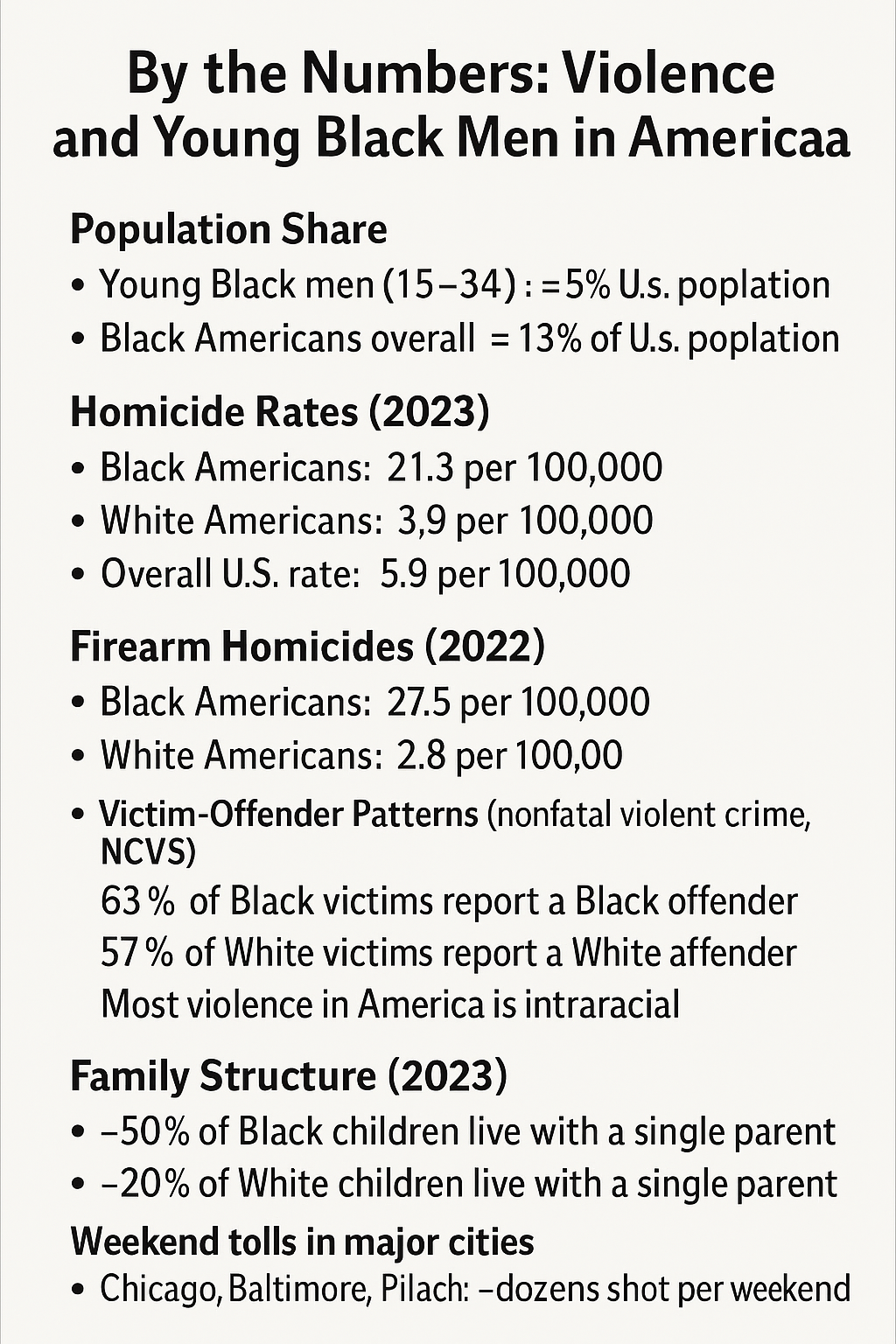By James Thompson

America’s homicide crisis is escalating (despite Democrat attempts to skew crime numbers), and young Black men remain trapped in a grossly outsized cycle of violence and victimization that far exceeds their share of the general population.
Black American men ages 15–34 account for just 5% of the U.S. population, yet they suffer homicide rates more than six times the national average.
In 2023, federal data show Black Americans were killed at a rate of 21.3 per 100,000, compared to just 3.2 per 100,000 for White Americans. Firearm homicides alone hit nearly 27.5 per 100,000 Black residents—a staggering figure that dwarfs those of every other racial group.

Why?
The tragedy is not just in the numbers, but in the lived reality. In Chicago, Baltimore, Philadelphia, and scores of other Democrat-run “Blue Cities,” shootings are measured in dozens per weekend. The overwhelming majority of both offenders and victims are young Black men. And despite public perception, the violence is overwhelmingly intraracial (Balck-on-Black): about 63% of violent crimes against Black victims are committed by other Black offenders, according to the National Crime Victimization Survey. Contrary to what many legacy media outlets claim, very few are committed by police.
A Cycle Rooted in Poverty and Family Instability
Researchers point to a web of interconnected drivers: segregated, under-resourced neighborhoods, failing public schools, and high rates of single-parent households. In 2023, nearly half of Black children lived with a single parent, compared to about one in five White children. Critics argue that decades of welfare policy discouraged family stability, and that “marriage penalties” in tax and welfare benefit systems risk making poor families worse off if they legally wed.
The result is a generation of boys too often raised without consistent male role models, in neighborhoods where crime networks wield more influence than families, schools or churches. As one Chicago pastor put it recently: “We’re asking young men to build a life on quicksand.”
Violence Beyond the Black Community
The violence does not remain contained. The shocking murder of Iryna Zarutska, a 23-year-old Ukrainian refugee fatally stabbed on Charlotte’s light rail a few days ago drew national headlines and underscored broader anxieties about crime crossing racial lines. Hispanic and Asian communities in urban centers are also reporting rising victimization rates, though the overall pattern remains heavily concentrated within racial groups themselves.
What Works—and What Doesn’t
While political debates rage over policing, incarceration, and gun laws, researchers have quietly identified interventions that consistently save lives.
- Focused deterrence strategies, such as the Group Violence Intervention model, have cut homicides sharply in cities that apply them with fidelity. These programs zero in on the small networks responsible for the majority of shootings, pairing swift enforcement with real offers of services and escape routes.
- Youth interventions like Chicago’s Becoming a Man program have shown remarkable results, reducing violent-crime arrests by more than a third through cognitive-behavioral therapy and mentoring.
- High-dosage tutoring and strong schools in disadvantaged areas attack the root of intergenerational poverty by raising achievement and keeping at-risk youth connected to opportunity.
- Mobility programs that help families move into safer, higher-opportunity neighborhoods when children are young have lasting effects, producing higher adult earnings and more stable families.
These approaches stand in contrast to broad “tough on crime” sweeps that often criminalize entire communities while missing the small, tightly connected groups who actually drive the violence.
A National Responsibility
The cost of inaction is measured in human lives and lost futures. Every weekend, headlines announce the toll: “12 shot, 3 killed overnight” in many cities. Each figure represents not just a victim, but a family torn apart, a neighborhood further traumatized, and a society that has failed to deliver equal safety and opportunity.
If America is serious about addressing its most urgent public safety crisis, it must confront the uncomfortable truth: a small share of the population, disproportionately young Black men, bear the brunt of the nation’s violence epidemic–as perpetrators and victims.
Breaking that cycle will require more than policing alone. It demands rebuilding families, repairing schools, reforming welfare policies, and investing in proven strategies that offer young men a path to middle-class stability rather than early graves.
Until then, the “normal” American life—safe streets, good schools, stable families—will remain out of reach for too many of those who need it most.
President Donald Trump is launching a sweeping policing of troubled cities with federal assets in the hope of reducing crime and saving lives. His foray into Washington, D.C. with a federal presence has yielded fantastic results, sparing the lives of many young Black American men. However, Democrats are boisterously against such efforts, screaming in the streets that they are happy with the status quo in their war-torn cities, and that Trump is a fascist dictator to seek peace and safety in our cities. We expect to see the effort expanded to many Blue Cities in the next few months, and when Trump succeeds, we will see what can be done for the young Black men and their families who live to make a change.
James Thompson is an author and ghostwriter, and a political analyst.
Sponsored by BasicInfo123 — simple bite-sized guides for life, money, civics, and more—because some stuff school just didn’t cover.

Leave a Reply